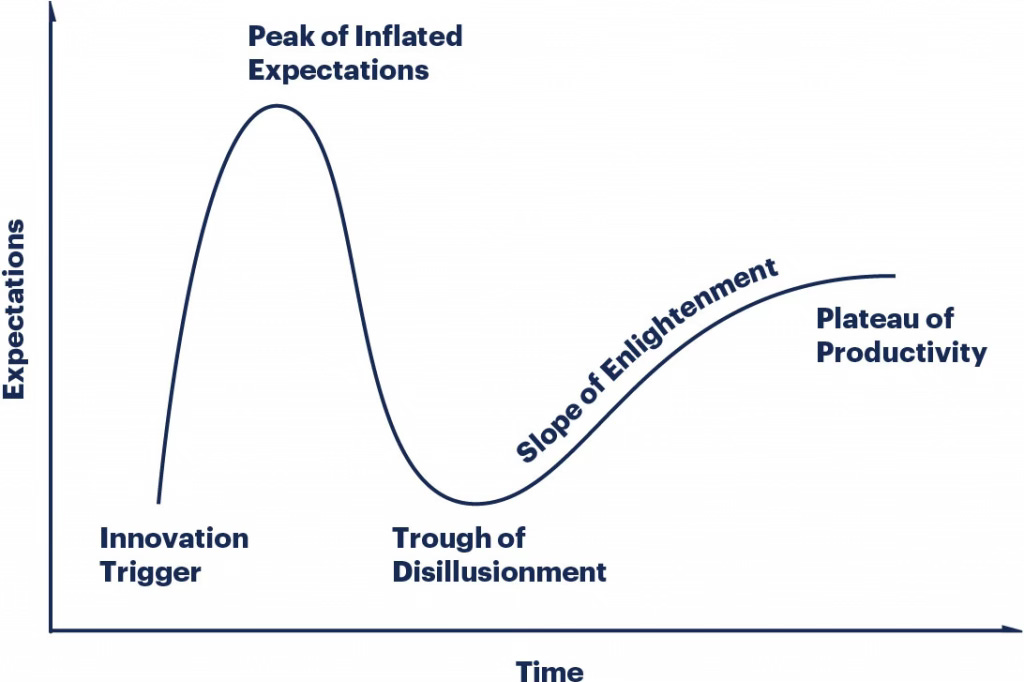Human Capital Intel - 4/1/25
Poor training = AI bust | Coastal rust | Fear rises in the workplace | GenZ abuses Family and Medical Leave Act | LinkedIn overrun by 'influencers'
Welcome to the latest edition of Human Capital Intelligence, your weekly brief synthesizing over 250 leadership, HR, and people sources to filter out the noise. As always, we would love to hear from you at ken@reyvism.com with questions you’d like answered or topics covered.
Sent this by a friend? Sign up here to receive HCI in your inbox every week.
By Ken Stibler; Powered by Reyvism Analytics
Get ready for the AI expectation crash
Despite surging corporate AI spending—now comprising 12-15% of 2025 IT budgets—more than one-third of executives already characterize their generative AI initiatives as "massive disappointments." This isn’t inherently surprising, traditional AI development projects - as opposed to the adoption of new AI tools - are known for failing upwards of 90% of the time. Still, the business media has been raising the expectations and hype around the new tools.
That’s about to change. HCI’s sentiment monitoring tool, which filter through media articles and social media like LinkedIn, is seeing a steady uptick in the amount of negative coverage of AI.
With many companies several months to a year into AI efforts, we’re reaching what Gartner’s hype cycle calls the “Trough of Disillusionment,” where the early promise of new tech goes through the sticks and stones of real enterprise adoption.
The internet, social media, and iPads, all went through similar declines, so it’s nothing for concern. In fact, a break in the pace would be welcome and provide organizations and individuals time to catch up with an oppressively quick pace of innovation. The break is also critical to solve the organizational barriers which are complicating AI gains.
For instance, 41% of Gen Z and Millennial workers admit to actively "sabotaging" AI adoption efforts, refusing to use new tools or abandoning training programs. Widespread employee resistance coupled with 60% of business reporting friction between functional teams about AI, shows serious organizational work is needed to make repeat the rewards of tech.
The core problem isn't the technology itself but the failure to prepare and organization for AI integration. Companies are prioritizing procurement over readiness, neglecting the critical groundwork of data management and workforce upskilling. Even documented successes—like the 95% acceleration in employee search speeds reported by the Josh Bersin Company—remain inaccessible to organizations with disorganized information architecture and inadequate change management strategies.
As employees confront AI tools they neither understand nor trust, frustration builds and promised productivity gains evaporate, leaving executives questioning their investments.
The Trough is inevitable, but how CEOs react will subtly be a significant decision for organizational competitiveness over the following months (not even years). Do you use the steady stream of negative stories to write off a scary new technology as a fad? Or do you use the time to learn, invest in core human and informational infrastructure, and set your organization up to be a success story once the sentiment on AI articles turns again?
What’s Next: Adopting AI requires the right informational and human infrastructure for the tools to make much of an impact, getting the IT, operations, and HR principles to align on an AI adoption strategy that checks the three boxes is critical to unlock the serious savings some F500 companies are already seeing.
The decline in “knowledge work” has begun
Three stats shocked me this week into writing about struggles in the white collar job market:
Employment for computer programmers in the U.S. has fallen to its lowest level since 1980.
The unemployment rate for 20–24-year-olds with a bachelor’s degree is now higher than for those with associate degrees.
More federal employees have been laid off in Q1 25 than white collar jobs have been created since 2023.
No wonder tech CEOs are encouraging their kids to go into art, betting that creativity will be harder to automate. If these trends continue, and there are strong reasons to believe this is a structural trend, not just a recession. The political and economic implications will be slow (3-5 years out) but massive (white collar consumers make up nearly 50% of consumer spending).
This is worth tracking: to adjust hiring and comp strategies, but also for your kids/grandkids who are bearing the brunt of some serious structural changes to labor markets.
What’s Next: The “right path” is ending. Getting kids involved in the business early, avoiding masters degrees without a hyper-clear reasoning, and aligning with growing sub-sectors of labor demand are now critical.
For companies with a strong competence in training or mentoring, there are some diamonds in the rough ( around 15% of GenZs hate their generation and skew more “old soul”). For everyone else, the market is expected to pay less for new back office workers.
Quote of the Week:
“What we’re finding is that for all the technology in the world, nothing is faster than the speed of human interaction. A thirty-second conversation can replace an email back-and-forth that goes on for hours or even days.”
— Michael Dell, CEO at Dell
Reading List:

GenZ learns how to leverage Family and Medical Leave Act
Generation Z workers are strategically using FMLA leave as a strategic workplace tool. HR experts report a concerning uptick in FMLA usage among this cohort, who appear to be leveraging the legally protected unpaid leave—originally designed for specific family and medical needs—as an escape valve from workplace dissatisfaction.
This places employers in a tough spot: businesses have a legal obligation to approve qualifying FMLA requests, with denials requiring a valid reason under both federal regulations and company policy.
What’s Next: If claims start going up and disrupt work, then consider working with HR and legal counsel to build the internal policy and understand the clear conditions necessary to reject such claims.
Afraid and anxious, Americans aren't bringing their best to work
Worker sentiment has transformed from quiet resignation to active fear as hiring reaches a five-year low. This shift from passive disengagement to acute anxiety is reshaping workplace psychology, where layoff survivors face mounting responsibilities without clear direction, creating not just disengagement but anticipatory dread.
What’s Next: With layoffs being highly visible across news, social networks, and friend groups, clearly communicating workforce plans can help discharge fear and get employees’ minds back to work.
LinkedIn gets overrun by 'influencers'
LinkedIn is being transformed by a surge of content creators monetizing personal brands, frequently posting “content” in the hopes of building a large audience and earning up to $3,000 per sponsored post. The platform is leaning in with "creator mode" features and video capabilities.
As Gen Z users flock to the platform and brands celebrate the "stickiness" of LinkedIn marketing compared to traditional social media, authentic professional discourse risks being overwhelmed by the same influencer ecosystem that has degraded other platforms.
What’s Next: If your business depends on LinkedIn for advertising or sales, get ready to go through the same “enshitification” seen in other platforms, where trust declines and conversion rates drop. HCI hasn’t seen any valid alternatives, but we are on the lookout.
Data Point:
In Other News:
US corporate profits hit record high before Trump's tariffs. But tariff impacts start to appear in data. (Reuters) (Fitch Ratings)
What skills do employers want? AI literacy and conflict management, LinkedIn says. (HR Dive)
Snapchat CEO: I give my employees an ‘almost impossible’ task on their first day—that way, they’ve ‘already failed’ early. (CNBC)
Government jobs: The soft underbelly of U.S. job growth. (Axios)
Bringing workers back to the office? Here's how to avoid a lawsuit. (Employee Benefits News)
Small Business Administration Planning to Cut More Than 40% of Its Workforce. (Wall Street Journal)
JPMorgan trades DEI for ‘DOI’. (HR Dive)
Retirement surge is a demographic time bomb. Can tech boost the expertise transfer? (HR Executive)






